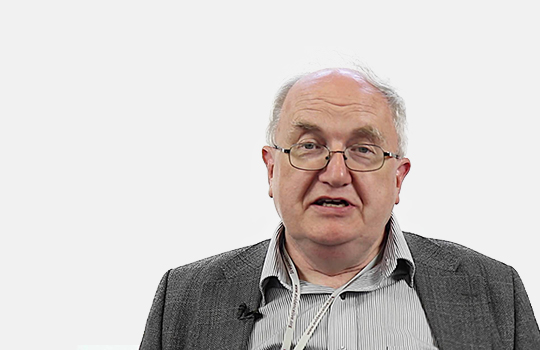 NEJM 27 Mar 2014 Vol 370
NEJM 27 Mar 2014 Vol 370
1189 I sing the body mitotic: we are a mass of cells dividing, mutating, cannibalizing, spreading. The wonder is not that we ever die of cancer, but that we often don’t. Cells which become aggressive are extraordinarily versatile at remaining aggressive, as shown by the relatively rare ALK-Rearranged Non–Small-Cell Lung Cancer. This accounts for about 5% of non small cell lung cancers, and its invasiveness seems to be caused by mutations of the anaplastic lymphoma kinase gene (ALK). So the majority of these tumours show an initial response to crizotinib, a drug which inhibits ALK. But the nasty fact is that within a year, the cells no longer respond. A new ALK-targeting drug is ceritinib, the subject of a phase 1 trial reported here. It is promising: “Ceritinib was highly active in patients with advanced, ALK-rearranged NSCLC, including those who had had disease progression during crizotinib treatment, regardless of the presence of resistance mutations in ALK.” But having learnt habits of aggression, those cells may yet prove deadly. Ceritinib is described as “20 times as potent as crizotinib against ALK” in this Novartis-sponsored trial, but that figure means nothing in itself. The proof will be in the phase 3 trial.
1198 Do you suffer from wandering mouse syndrome? If so, place http://www.jameslindlibrary.org/ on your Favourites list, and then as your right hand moves about seeking some excuse not to get on with your work, you can find out about all sorts of wonderful people who helped to make medicine safe and effective. Near the top of my list is John Haygarth (1740-1827), who was the first person to separate fever patients from other patients in his hospital in 1783. Not only did this prevent cross-infection with the surgical patients, but only one of his 30 fever patients died that year—quite incredible in the pre-antibiotic era. He also succeeded in eradicating smallpox from Chester by mass inoculation. Hospital infection still affects 4% of patients in American hospitals. As device and procedure associated infections decrease, control of C difficile may become relatively more important.
JAMA Intern Med Mar 2014
OL When David Sackett came to Oxford as professor of evidence based medicine twenty years ago, he devised an evidence trolley to take on ward rounds, carrying all the latest electronic equipment—a clunky computer with a big monitor and lots of wires to connect it to telephone sockets and the like. The world wide web had just been invented, and nobody knew if e-mail was worth subscribing to or whether it would prove a passing fad. Dave wanted to prove that you could look up information to guide decision making in real time by the bedside. Now anybody can do it by diving into a pocket and pulling out their phone. But amazingly, the transition from the paper age to the smartphone age has made very little difference to the number of clinical questions that are raised and answered by clinicians at the point of care, according to this survey of studies carried out over several decades.
JAMA 26 Mar 2014 Vol 311
1209 On various occasions over the years, I have reported on reviews of Barrett’s oesophagus and opined that it might have been better had Barrett never invented it. Squamous changes around the gastro-oesophageal junction are very common, and whether you have the diagnosis depends largely on whether anyone has looked down there. The incidence of oesophageal cancer is climbing in the developed world, but most of it is not preceded by Barrett-like changes. So if you have this diagnosis, you are unlucky: it will hang over you, and you will take medication daily and have tubes put down you every 6-12 months so you can never forget that you are in a state of “pre-cancer.” According to the small European trial reported here (68 in each arm), if your Barrett’s oesophagus shows low-grade dysplasia, you could opt for radiofrequency ablation as first line treatment. Then your chances of having adenocarcinoma detected by biopsy after three years would go down from 8.8% to 1.5%. I hope somebody has sent in a poster about Barrett’s to the coming Overdiagnosis conference in September at Oxford. I can make nothing of the figures from different studies: these seem inordinately high.
1225 I never tire of praising Simon Griffin’s ADDITION-Cambridge study, which was reported in The Lancet in 2012 and should have put paid to the idea that any benefit would accrue from screening for diabetes and treating it aggressively. Yet there are still many vocal people calling for whole-population screening using glycated haemoglobin (HbA1c), on the grounds that it will help us select at-risk patients for special haranguing about lifestyle and exercise. This idea is further contradicted by the conclusion of an analysis of individual-participant data from 73 prospective studies involving 294 998 participants without a known history of diabetes mellitus or CVD at the baseline assessment. In these individuals, “additional assessment of HbA1c values in the context of CVD risk assessment provided little incremental benefit for prediction of CVD risk.” Another poster for the Overdiagnosis conference, please.
Lancet 29 Mar 2014 Vol 383
1129 It is not my usual habit to be polite about The Lancet’s phase 1 proof-of-concept studies, especially when they seem to be pushing some new market for devices or pharmaceuticals. But this was a publicly funded trial of retinal gene therapy which might—perhaps—one day—if all goes well—become a scalable treatment for many currently untreatable diseases of the retina. Choroideremia is a rare X-linked recessive disease that leads to blindness due to mutations in the CHM gene, and in this trial six patients were treated with a corrective gene encoded in an adenoviral vector. These people had only patches of retina left, but there were some really impressive improvements. “These findings lend support to further assessment of gene therapy in the treatment of choroideremia and other diseases, such as age-related macular degeneration, for which intervention should ideally be applied before the onset of retinal thinning.” I like the throwaway mention of macular degeneration, several hundred thousand times commoner than choroideremia.
1138 The next phase 1 trial was funded by Oxford BioMedica, which began as a commercial arm of my own university, so I might have to declare an interest if I was receiving money from that celebrated institution. They call their gene product ProSavin, and it uses a lentivirus to deliver the genetic material to the motor region of the striatum (putamen) and convert striatal cells into so-called “dopamine factories.” This requires complex stereotactic surgery, several PET scans, and a week in hospital, so it is never going to come cheap. Fifteen patients received the treatment, but the triallists struggle to find any benefit. “Although the efficacy findings show promise, the magnitude of effects are within the placebo range reported in other clinical trials for Parkinson’s disease using surgical techniques, and must be interpreted with caution.” So I can’t see ProSavin financing the University of Oxford for centuries to come, as penicillin might have if we had decided to take out a patent in 1941.
1147 An article about self-harm in Britain’s prisons produces feelings of shame and helplessness. Studies like these are supposed to inform policy and improve things, but you somehow know this won’t happen. In ten years’ time, you can bet that a quarter of female prisoners will still be harming themselves every year.
1155 When I first came across sarcoidosis as a medical student, I found it hard to believe that a fairly common granulomatous disease could exist without anyone having a clue what caused it. Forty years on, a state-of-the-art review begins, “Sarcoidosis is a systemic disease of unknown cause that is characterised by the formation of immune granulomas in various organs, mainly the lungs and the lymphatic system.” And without knowing what causes it, we’re no further forward with treating it, except that we have a few more toxic drugs to load into the blunderbuss.
BMJ 29 Mar 2014 Vol 348
French ladies proved unable to quit smoking while pregnant in 95% of cases, whether they used nicotine patches or not. But was this their preferred nicotine delivery route? I decided to see if this question had been addressed on Google. Sure enough, here is the quote: “Suppositoires à la Nicotine : Divers mieux que les patchs?”
Benzodiazepines, and to a lesser extent the “Z” drugs mostly used as sedatives, have had a bad press over several decades. This latest study based on the UK clinical practice research dataset finds that their use is associated with a doubling of mortality over a seven year period. But when the size of an association is implausibly high, interest turns towards alternative possibilities. I really don’t like the negativity of the word “confounders” because it is often used to mean “explainers”. I find it hard to believe that these drugs of themselves make people die. But they seem to be a marker for people who are more likely to die, so what could be the missing explainer? Perhaps anxious, sleepless people simply give up more easily. They almost certainly become less active. There is more in heaven and earth, Horatio, than is recorded in your CPRD.
I have never prescribed agomelatine, an antidepressant which was introduced a year before I retired from weekday general practice. If I were looking after depressed people now, I might suggest it to some of them, because this meta-analysis of published and unpublished studies shows that it is an effective antidepressant. What I would like to know most, though, is what does not appear in any of the studies, published or unpublished: does this drug cause immediate or long-term withdrawal effects, such that patients are likely to have to take it indefinitely? That is the central problem with prescribing serotonin reuptake inhibitors. If agomelatine is better in that respect, then I’m all for it. But I wonder if we will ever know. In the mean time, this thorough meta-analysis represents one of the first fruits of full data release by the European Medicines Agency. All future meta-analyses should be based a similarly complete dataset of all human trials.
“The NHS has been collecting data on patients’ experience of care for over 10 years but few providers are systematically using the information to improve services. Angela Coulter and colleagues argue that a national institute of “user” experience should be set up to draw the data together, determine how to interpret the results, and put them into practice.” Amen.
Plant of the Week: Helleborus x hybridus “Harvington Yellow”
With spring now in full early beauty, it may seem odd to choose flowers that have already been out for a month, but in our garden the oriental hellebores are currently at their peak, and there is nothing to equal them. On our heavy limy soil, hellebores spread readily, and we have long given up buying any in—except for this one.
Most oriental hellebores are within the range from white to deepest plum-purple, with speckles, green fringes and various pretty arrangements of petals and stamens. They don’t like being split so we tend just to let them flourish where they spring up from seed. A few are a bit washy, but most are lovely. They are poisonous in all their parts, so unsuitable for gardens where small children may turn herbivorous.
In the last two decades, breeders have created varieties which approximate to true clear yellow. The Harvington Yellows are lovely but I suspect they are grown from seed and need to be selected while in flower. If you have left buying yours till now, you may too late.
